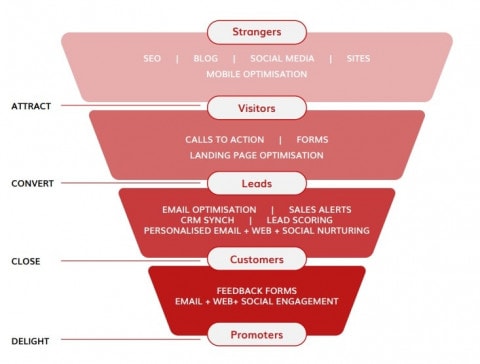How inbound marketing strategy works for membership organisations

Inbound marketing strategy, like many other marketing methods, goes beyond B2B, B2C, and nonprofit marketing. Inbound marketing also isn’t about just closing sales, it’s about identifying your target market and building trust with those in it.
The principles and tactics of inbound marketing strategy apply whether you are a business trying to acquire customers or a membership organisation trying to acquire new members and engage your current members.
The first main principle of inbound marketing for your membership organisation is that all of the components of your inbound marketing strategy need to be about your members (and potential members). Unlike traditional marketing, inbound marketing strategy is not all about you. It is a little bit about you, but your membership organisation needs to publish content and engage with your prospects on their terms. This means talking to your prospects about what makes them tick, and through the communication channels they prefer to use. All this helps to establish your organisation as a trusted authority. Building a relationship as a trusted authority is how you gain the credibility to inspire prospects to act later on.
In this day and age, it is very easy for people to screen cold calls, throw out snail mail, and ignore spam emails that don’t stand out in their inboxes. Furthermore, the old strategies of sending out high-gloss reports or buying time for on-air ads don’t return the same number of prospects as inbound marketing.
If you want to recruit new members for your membership organisation and keep them active and inspired, your membership organisation needs to align its marketing strategies to the inbound marketing methodology.
The second main principle of inbound marketing strategy is using your membership organisation’s content to gently lead prospects through each phase of the inbound marketing methodology. For every piece of content that your organisation publishes, you should ensure that it targets your membership marketing personas, which phase they are currently in, and where you want them to go next.

There are five actions that you must take in order to obtain visitors, leads, customers and promoters: Attract, Convert, Close, Delight and Analyse.
In order to achieve these actions there are tools that you can use. The diagram above shows which tools align with which action.
However, always bear in mind that while the diagram shows where the tools come first come into to play, it doesn’t mean that this is the only place they are applicable. Several tools, for example email, can be essential in several stages of the inbound methodology.
The inbound marketing funnel
While the concept of the sales funnel is not a new one, inbound marketing strategy has developed the sales funnel to help marketers visualise where a customer is in their buyer’s journey to better meet their needs, simply put this means publishing the right content at the right time in the right place.
Since this sales funnel is at the centre of a successful inbound marketing strategy, it is important to be able to move leads through the funnel and align your content with the buyer’s journey in order to attract, convert, close, and delight your ideal customers.
The buyer’s journey is split into three parts: Top of the Funnel (ToFu), Middle of the Funnel (MoFu) and Bottom of the Funnel (BoFu).
TOFU: Top of the Funnel
At the very top of your sales funnel you’re looking to attract a much larger audience of leads, because you’re working to attract relevant traffic without filtering or discouraging conversions. The most common form of ToFu content would be your blog articles. From there, calls-to-actions should lead ToFu prospects to conversion opportunities, like tip sheets or eBooks that encourage leads to trade their contact information for the helpful content inside. Your goal with ToFu content should be to educate your audience on a specific question, need or pain point that they’re looking to address, but without a sales tie-in. You will get the opportunity to do this with your MoFu content.
MOFU: Middle of the funnel
Once a lead converts on an initial ToFu content offer, they progress into the MoFu stage. This is viewed as the most complicated funnel stage because of the broad diversity of interested leads who haven’t been fully qualified. In this stage of the funnel, your content should continue to educate but also start the process of positioning your company as the solution to the lead’s needs and challenges. Advanced eBooks are a great form of content in this stage but case studies, white papers and videos will perform well at beginning to build your credibility.
BOFU: Bottom of the funnel
The BoFu stage is the most crucial in the funnel as at this point you are going for the sale. Your BoFu stage may not consist of content at all. At this point your leads know you and are comfortable engaging one-on-one. This is where a free assessment, evaluation or trial works nicely to start the dialogue and to begin to fully qualify your most interested leads.
The four key elements for successful inbound marketing

As you can see, the inbound marketing funnel has four phases:
-
Attract
The first step in the inbound methodology is “Attract”. You don’t want unqualified leads sent to your website, you want quality traffic, the people who are most likely to convert and be a happy member that returns. Examples of important tools used to attract qualified customers to your website are:
- Blogging
- Social Media Marketing
- Free E-Book
- Free Download
- Other Free Offer
- SEO
-
Convert
Once you’ve attracted the right customers to your website, your next step is to get their information and convert them. At the least, you’ll want an email address – after all, a person’s contact information is the most valuable currency there is to your membership organisation. Examples of important tools in converting visitors to leads are:
- Call to action
- Forms
- Landing Page
- Database
-
Close
You’ve attracted the right visitors and converted the right leads, now you just need to close and you’ve got a customer.
- Emails
- CRMS
- Marketing Automation
-
Delight
According to the inbound methodology, your organisation should continue to delight new members even after they have signed up. Keep providing exceptional and delightful service so that your current customers become your company promoters. Examples of important tools in delighting your customers include:
- Social Monitoring through Social Media
- Surveys
- Follow up calls
- Follow up emails
Getting started with an inbound marketing strategy for your membership organisation
When it comes to an inbound marketing strategy for your membership organisation, the more you invest, greater your return. Creating useful content takes time and a lot of groundwork, but once you commit to the work the results will show how well it can pay off.
To get started with inbound you need to:
- Identify your ideal customer(s) and learn all you can about them. You can’t begin to write content that will resonate with your customers until you know what makes them tick.
- Determine what makes you remarkable. What is your unique and compelling story? Why should your audience listen to you?
- Choose your delivery platforms. Will you blog? Tweet? Use Facebook and LinkedIn?
- Create and commit to a steady content schedule. It is important to create a schedule that will consistently produce fresh and relevant content to continue to engage your audience. Bear in mind that your themes should focus on customer issues and not on your business.
Focus on quality rather than quantity. You should be focused on creating content that educates your audience and builds brand authority. The right content will be shared which will increase you reach and with this increasing awareness, trust and ultimately leads.
Also, don’t forget to set aside time for weekly analysis. This will help you in understanding how effective your efforts have been and what can be improved.
Ready to recruit more members with an inbound marketing strategy?
If traditional marketing methods are failing to deliver more members for your membership organisation, at Artonezero we can get you more leads with an Inbound marketing strategy.
If you are ready to benefit from inbound marketing, we would love to have a chat with you today – simply get in touch and we can talk about how we can create the best inbound marketing strategy for your organisation.



